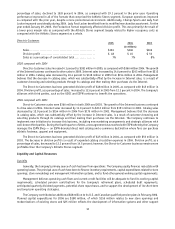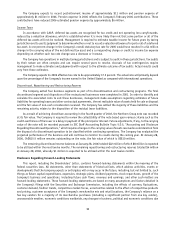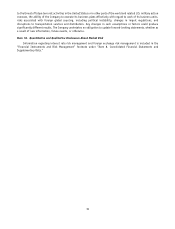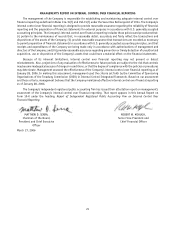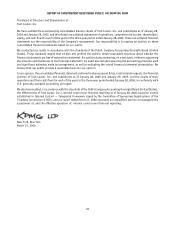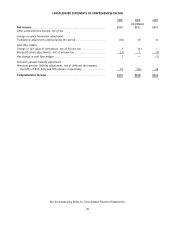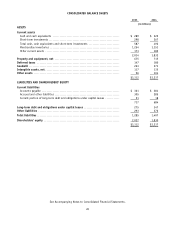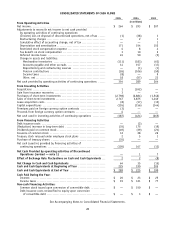Foot Locker 2005 Annual Report Download - page 34
Download and view the complete annual report
Please find page 34 of the 2005 Foot Locker annual report below. You can navigate through the pages in the report by either clicking on the pages listed below, or by using the keyword search tool below to find specific information within the annual report.
The Company expects to record postretirement income of approximately $11 million and pension expense of
approximately $1 million in 2006. Pension expense in 2006 reflects the Company’s February 2006 contributions. These
contributions have reduced 2006 estimated pension expense by approximately $6 million.
Income Taxes
In accordance with GAAP, deferred tax assets are recognized for tax credit and net operating loss carryforwards,
reduced by a valuation allowance, which is established when it is more likely than not that some portion or all of the
deferred tax assets will not be realized. Management is required to estimate taxable income for future years by taxing
jurisdiction and to use its judgment to determine whether or not to record a valuation allowance for part or all of a deferred
tax asset. A one percent change in the Company’s overall statutory tax rate for 2005 would have resulted in a $4 million
change in the carrying value of the net deferred tax asset and a corresponding charge or credit to income tax expense
depending on whether such tax rate change was a decrease or increase.
The Company has operations in multiple taxing jurisdictions and is subject to audit in these jurisdictions. Tax audits
by their nature are often complex and can require several years to resolve. Accruals of tax contingencies require
management to make estimates and judgments with respect to the ultimate outcome of tax audits. Actual results could
vary from these estimates.
The Company expects its 2006 effective tax rate to be approximately 37.5 percent. The actual rate will primarily depend
upon the percentage of the Company’s income earned in the United Stated as compared with international operations.
Discontinued, Repositioning and Restructuring Reserves
The Company exited four business segments as part of its discontinuation and restructuring programs. The final
discontinued segment and disposition of the restructured businesses were completed in 2001. In order to identify and
calculate the associated costs to exit these businesses, management made assumptions regarding estimates of future
liabilities for operating leases and other contractual agreements, the net realizable value of assets held for sale or disposal
and the fair value of non-cash consideration received. The Company has settled the majority of these liabilities and the
remaining activity relates to the disposition of the residual lease liabilities.
As a result of achieving divestiture accounting in the fourth quarter of 2002, the Northern Group note was recorded
at its fair value. The Company is required to review the collectibility of the note based upon various criteria such as the
credit-worthiness of the issuer or a delay in payment of the principal or interest. Future adjustments, if any, to the carrying
value of the note will be recorded pursuant to SEC Staff Accounting Bulletin Topic 5:Z:5, “Accounting and Disclosure
Regarding Discontinued Operations,” which requires changes in the carrying value of assets received as consideration from
the disposal of a discontinued operation to be classified within continuing operations. The Company has evaluated the
projected performance of the business and will continue to monitor its results during the coming year. At January 28,
2006, CAD$15.5 million remains outstanding on the note, the fair value of which is US$10 million.
The remaining discontinued reserve balances at January 28, 2006 totaled $22 million of which $8 million is expected
to be utilized within the next twelve months. The remaining repositioning and restructuring reserves totaled $4 million
at January 28, 2006, whereby $1 million is expected to be utilized within the next twelve months.
Disclosure Regarding Forward-Looking Statements
This report, including the Shareholders’ Letter, contains forward-looking statements within the meaning of the
federal securities laws. All statements, other than statements of historical facts, which address activities, events or
developments that the Company expects or anticipates will or may occur in the future, including, but not limited to, such
things as future capital expenditures, expansion, strategic plans, dividend payments, stock repurchases, growth of the
Company’s business and operations, including future cash flows, revenues and earnings, and other such matters are
forward-looking statements. These forward-looking statements are based on many assumptions and factors detailed in
the Company’s filings with the Securities and Exchange Commission, including the effects of currency fluctuations,
customer demand, fashion trends, competitive market forces, uncertainties related to the effect of competitive products
and pricing, customer acceptance of the Company’s merchandise mix and retail locations, the Company’s reliance on a
few key vendors for a majority of its merchandise purchases (including a significant portion from one key vendor),
unseasonable weather, economic conditions worldwide, any changes in business, political and economic conditions due
18






